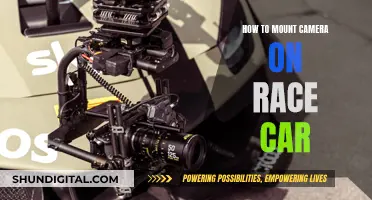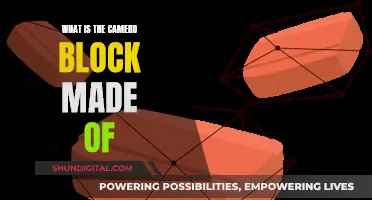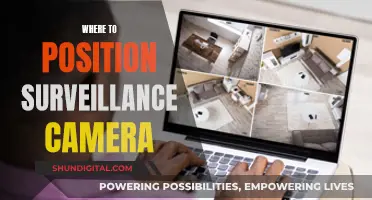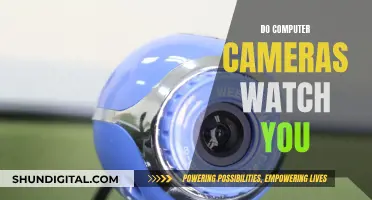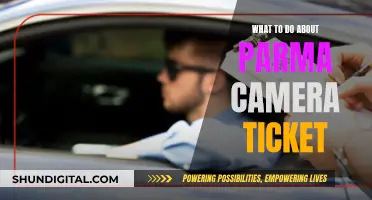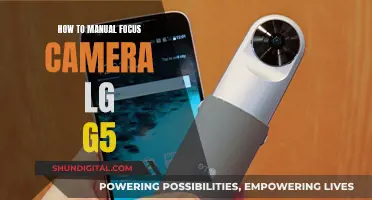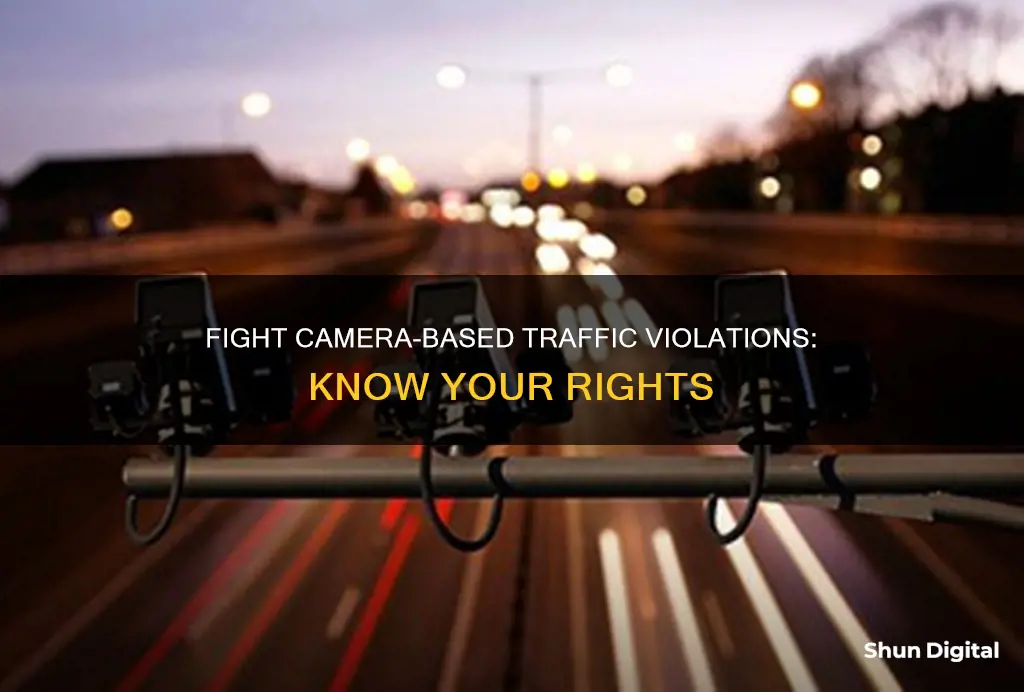
If you've received a traffic violation caught on camera, there are a few steps you can take to contest it. Firstly, examine your ticket and check the date, time, and location. As camera tickets are usually sent to the owner of the car, you should confirm that you were driving the car when the ticket was issued. You can then review any photos or videos included with the ticket to ensure it's your car and that the photo is clear. If you were driving, try to remember the details of the incident and write them down. You should also make a note of the exact code section you're cited for violating and research the applicable law. Once you've gathered this information, you can plead not guilty by mail, online, or in person, depending on the jurisdiction. If you intend to plead not guilty, you may need to appear at an arraignment and request a formal hearing. You can then build your defence by researching relevant cases and laws and present your case in court.
| Characteristics | Values |
|---|---|
| Check ticket details | Check the date, time, and location of the ticket. Confirm you were driving the car when the ticket was issued. |
| Understand the law | Read the law to understand the elements of the violation and the associated penalties. |
| Review photos and videos | Request and review photos and videos of the incident to confirm the car and license plate details. Blurry photos may be used as a defense. |
| Plead not guilty | Plead not guilty by mail, online, or in person at an arraignment. Do not pay the fine if this is considered an admission of guilt. |
| Request documents | Request documents such as maintenance records for the camera and traffic light system to establish their accuracy and reliability. |
| Research applicable law | Research cases and appellate court decisions related to traffic cameras in your city or county. |
| Present your defense | Attend the hearing, present your case, and introduce evidence such as diagrams, photographs, and eyewitness statements. |
What You'll Learn

Check if you were driving
The first thing to do when you receive a traffic violation ticket is to check the date, time, and location of the ticket. Camera tickets are sent to the owner of the car, not the driver, so make sure you were actually the one driving the car when the ticket was issued. If someone else borrowed your car, you cannot be prosecuted. However, some states, like New York, treat red-light camera tickets as parking violations, holding the registered owner liable. Therefore, it is important to check the red-light law in the jurisdiction where you received the ticket.
If you were driving, try to reconstruct the scene and write down any details you remember. For example, you may have been making a legal right turn on red when the camera took the photo. If you were performing a legal manoeuvre, you should be able to get the ticket dismissed.
Review the photos that came with your notification. Confirm that it is your car in the photo and that the photo is clear. If the license plate isn't clearly visible, it may be difficult to confirm that the car is yours. Additionally, if there is no clearly identifiable photo of you in the driver's seat, this may be another defence, especially if you live in a jurisdiction that requires tickets to follow the driver, not the registered owner of the car.
The Evolution of the 75' Camaro: A Rare Breed
You may want to see also

Check the photos/video
If you've received a traffic violation ticket, you should first check the date, time, and location of the ticket. This is because the ticket is sent to the owner of the car, not the driver, so you need to make sure that you were driving the car when the ticket was issued. If someone else borrowed your car, you can't be prosecuted. However, in some states, such as New York, the registered owner of the vehicle is held liable.
Next, review the photos and/or videos. Confirm that it is your car in the photo and that the photo is clear. If the license plate isn't clearly visible, it may be difficult to confirm that the car is yours. If there's no clearly identifiable photo of you in the driver's seat, this may be another defence. You will be under oath, so you can't argue that you weren't driving if you were, but you can argue that the prosecution can't prove you were driving. If photos were not included with your citation, you may need to wait until after your trial is scheduled to request copies from law enforcement.
If the photos and/or videos show that you crossed the limit line or entered the intersection after the light turned red, there's proof that you violated the law. However, if the photos and/or videos don't show a violation, you can use them to your advantage in getting the ticket dismissed.
In some states, there are requirements for signage to tell drivers that red light cameras are in use at an intersection. If you were cited for a violation in an intersection that didn't have the required signage, you might have a good defence.
Keep Your Camera Ready: Battery Storage While Traveling
You may want to see also

Check the camera's maintenance records
When contesting a traffic violation by camera, it is important to request the camera's maintenance records. This can be done by filing a Discovery request, which will put an end to the city's delaying tactics in providing the records. The request should be made in writing and sent to the relevant authorities, including the city attorney, city prosecutor, district attorney, and court. It is recommended to send the request via fax and certified mail to ensure receipt.
The maintenance records will provide information on the calibration and maintenance of the camera system. This information is crucial to determine if the camera was functioning properly at the time of the alleged violation. If the camera was not properly calibrated or maintained, it could call into question the accuracy of the violation.
In addition to the maintenance records, it is also important to request other relevant documents such as photos, videos, and reports related to the traffic violation. These documents can be used as evidence to support your case. When requesting these documents, it is essential to be specific about what you need and to provide any relevant information such as the date, time, and location of the violation.
It is important to act promptly when requesting the camera maintenance records and other relevant documents. The sooner you make the request, the higher the chances of obtaining the necessary information to build a strong case. Remember to keep track of all correspondence and responses received during the process.
By thoroughly reviewing the camera maintenance records and other relevant documents, you can identify any discrepancies or issues that may help in contesting the traffic violation by camera.
Obtaining Traffic Camera Footage: A Guide for Californians
You may want to see also

Challenge the admissibility of the photo
Challenging the admissibility of a photo in court is a complex process that requires a good understanding of the law. Here are some ways to challenge the admissibility of a photo taken by a traffic camera:
Hearsay Evidence
In some jurisdictions, a red light camera photo may be considered hearsay. Hearsay is an out-of-court statement used in court to prove the truth of the matter asserted. While hearsay evidence is usually inadmissible, there are exceptions. In the case of traffic camera photos, some courts have allowed them as evidence while others have not. Research your jurisdiction to determine if this objection applies in your case.
Right to Confront Witnesses
The Sixth Amendment of the US Constitution guarantees your right to cross-examine witnesses. In the case of a traffic camera photo, you have the right to confront a witness who maintains the record and system associated with the camera. If no such witness appears, you can object to the use of the photographs on these grounds.
Authenticity of the Photograph
If no one from the company that maintains the camera testifies in court, you can object to the use of the photographs on the grounds of lack of foundation. The prosecution must present evidence that the camera, the system connecting it to the traffic light, and the traffic light itself were functioning properly to establish the foundation for the photo's reliability and admissibility.
Lack of Evidence
Even if the photos are clear and admissible, if they do not clearly show you driving the vehicle, you can argue that the prosecution cannot prove you were the driver. Additionally, the photo does not prove that the traffic light was functioning properly. The prosecution must prove that the traffic light was working correctly to establish that you ran a red light.
Other Defenses
If your challenges to the camera photo are unsuccessful and the photo is admitted as evidence, you can still present other defenses. For example, if you were speeding to get to the hospital or to avoid harm, you can argue a necessity defense, which acknowledges the violation but provides a valid reason for it.
Mastering Camera Mode in Elite Dangerous
You may want to see also

Argue that the violation was a 'mistake of fact'
Arguing that a traffic violation captured by a camera was a mistake of fact can be a valid defence strategy. Here are some ways to approach this:
Understand the Violation and the Applicable Law
First, it is important to understand the specific violation you are being charged with and the relevant law. Review the photos and videos provided with your ticket, as well as the state law pertaining to red light cameras. The available defences may depend on the specifics of the law.
Argue That You Weren't Driving
In most states, it is the driver, not the vehicle owner, who is liable for the violation. If someone else was driving your car when the violation occurred, you may be able to submit an affidavit stating that you were not the driver. This could result in the dismissal of the ticket.
Challenge the Evidence
Review the photos and videos provided to ensure they clearly show a violation. For example, in the case of a red light violation, the evidence must show that your vehicle crossed the limit line or entered the intersection after the light turned red. If the evidence does not clearly show this, you may be able to argue that no violation occurred.
Check for Required Signage
Some states require the presence of signs informing drivers that red light cameras are in use at an intersection. If the required signage is not present or does not meet the specified requirements (such as location or wording), you may have a valid defence against the ticket.
Understand the Difference Between Errors and Violations
It is important to understand the distinction between errors and violations. Errors are unintended deviations from preferred behaviour, while violations are deliberate and conscious decisions to break the rules. Arguing that your action was an error of judgement or a mistake, rather than an intentional violation, can be a key part of your defence.
Provide Alternative Explanations
Instead of refuting the facts presented by the prosecution, you can try to provide alternative explanations for your actions. For example, you may argue that you needed to speed temporarily to pass a driver who appeared to be drunk and posing a threat to your safety. Alternatively, you could explain that you swerved lanes due to a medical emergency, and immediately pulled over to prevent endangering other drivers.
Finding Night Mode: Camera Settings Explored
You may want to see also
Frequently asked questions
Check the ticket details, including the date, time, and location. Confirm whether you were driving the car when the ticket was issued.
Common defences include:
- You weren't driving the vehicle when the violation occurred.
- The photos and videos do not clearly show a violation.
- There were no warning signs about the red light camera at the intersection.
- The yellow light interval was shorter than the minimum required time.
Plead "not guilty" and be prepared to present your case and evidence in court. You may also need to pay a deposit or citation fee.


